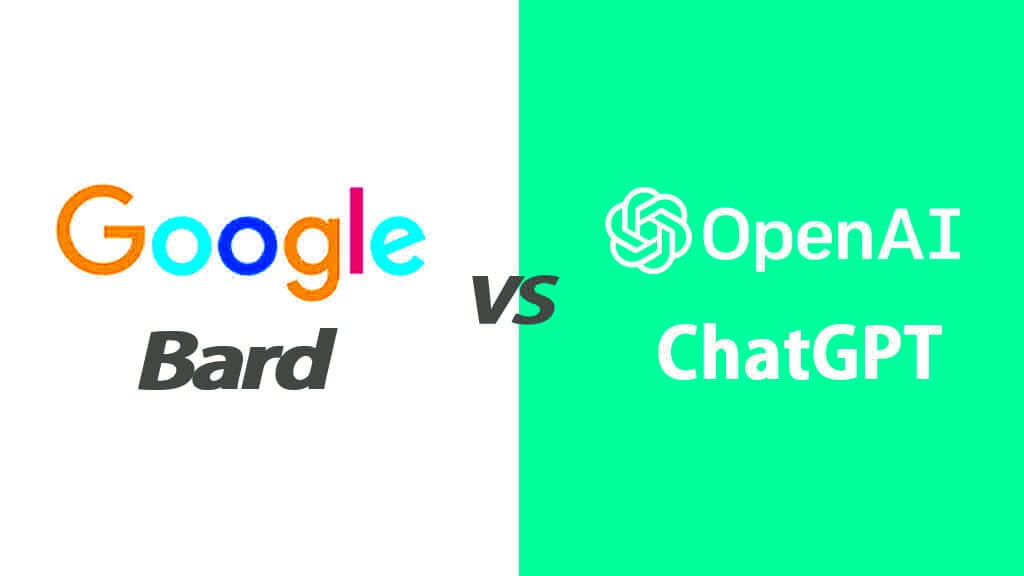Google Bard vs ChatGPT
ChatGPT is a language model developed by OpenAI, a leading artificial intelligence exploration association. OpenAI was innovated in 2015 by Sam Altman, Greg Brockman, Elon Musk, Ilya Sutskever, John Schulman, and Wojciech Zaremba with the thing of advancing artificial intelligence in a responsible and safe manner. OpenAI has since come one of the leading associations in the field of AI, with a focus on developing slice- edge AI technologies and advancing the state of the art in AI exploration. Click on “ What’s ChatGPT and How it Works ” to Information about ChatGPT?
While, Bard is Developed by Google Company. Google’s CEO Sundar Pichai has lately introduced its new artificial intelligence chatbot called “ Bard ”. Google SEO Stated ““ seeks to combine the breadth of the world’s knowledge with the power, intelligence and creativity of our large language models. Bard will be an outlet for creativity, a helipad to answer your questions and help clarify new effects “ This chatbot functions also to ChatGPT, allowing druggies to interact with it through discussion. The technology behind Bard is grounded on Google’s Language Model for Dialogue operation( LaMDA), furnishing a largely advanced and sophisticated language model for dialogue operations.
What is ChatGPT
ChatGPT is an advanced AI language model developed by OpenAI. It is designed to engage in conversational interactions and provide helpful responses to a wide range of queries and prompts. Built upon the foundation of the GPT (Generative Pre-trained Transformer) architecture, ChatGPT has been trained on massive amounts of text data from the internet, allowing it to generate coherent and contextually relevant responses.
With its natural language processing capabilities, ChatGPT can understand and generate human-like text, making it an effective tool for tasks such as answering questions, providing explanations, offering suggestions, or simply engaging in a friendly conversation. While it is a powerful language model, it’s important to note that ChatGPT has limitations and may occasionally produce incorrect or nonsensical responses.
OpenAI has made continuous efforts to improve ChatGPT based on user feedback and iterative updates. By leveraging the collective knowledge within its training data, ChatGPT aims to be a helpful and reliable AI assistant, facilitating interactions in a conversational manner and providing assistance across a variety of domains.
What’s extraordinary about ChatGPT, specifically the GPT-3.5 architecture, is its advanced natural language processing capabilities. It’s able to understand and generate human-like text based on the input it receives. Here are a few key features that make it extraordinary:
- Natural Language Understanding: ChatGPT can comprehend and interpret human language, understanding context, nuances, and even subtle cues. It can answer questions, provide explanations, and engage in meaningful conversations.
- Contextual Responses: The model can maintain context over multiple turns of conversation, providing coherent and contextually relevant responses. This makes interactions feel more natural and fluid.
- Diverse Use Cases: ChatGPT can be used for a wide range of applications, including drafting emails, writing code, generating creative writing, providing tutoring, offering customer support, and more.
- Adaptability: It can be fine-tuned for specific tasks, allowing developers to tailor its behavior and outputs to suit particular use cases or industries.
- Multilingual Support: GPT-3.5 has been trained on text from various languages, enabling it to understand and generate content in multiple languages.
- Large-Scale Knowledge: The model has been trained on a massive amount of text from the internet, giving it a broad base of general knowledge up to its knowledge cutoff in September 2021.
- Creative Generation: It can generate creative and imaginative content, such as poetry, stories, and even new ideas. This has led to innovative applications in art and content creation.
- Assistance and Collaboration: ChatGPT can act as a helpful assistant, aiding users in various tasks, such as brainstorming, content drafting, and problem-solving. It can also be used as a tool for collaborative writing.
- Continual Learning: While GPT-3.5 doesn’t learn in real-time, it has the potential to be fine-tuned on new data, allowing it to improve and adapt to changing information.
- Accessibility: GPT-3.5 has the potential to make technology and information more accessible to individuals who might have difficulty with traditional interfaces or who speak languages with limited technological support.
It’s important to note that while ChatGPT is impressive, it’s not without limitations. It can sometimes produce incorrect or biased information, and it may not fully understand complex queries. It’s also not capable of genuine understanding or consciousness, as it operates based on patterns and data it has been trained on.
Exploring the Evolution: Unveiling ChatGPT-4’s Remarkable Capabilities
Introduction
In the ever-evolving landscape of artificial intelligence and natural language processing, ChatGPT-4 emerges as a groundbreaking milestone. Building upon the achievements of its predecessors, ChatGPT-4 takes conversational AI to new heights with its exceptional capabilities, enhanced contextual understanding, and wider range of applications. In this article, we delve into the intricacies of ChatGPT-4, exploring its features, advancements, and potential implications.
Contextual Understanding and Fluent Conversations
At the heart of ChatGPT-4 lies its unparalleled ability to comprehend context. The model’s advanced architecture allows it to maintain a coherent and relevant conversation across multiple turns. This ensures that interactions feel more human-like, with the AI grasping nuances and subtleties that previous iterations might have missed. As a result, users experience conversations that are not only accurate but also contextually engaging, leading to more satisfying interactions.
Expanded Knowledge Base
ChatGPT-4’s development has been fueled by a vast and diverse dataset, giving it an extensive knowledge base spanning various domains up until its last training data update. This translates to a heightened ability to provide accurate information, explanations, and insights on a wide array of subjects. Whether it’s explaining complex scientific concepts or offering historical context, ChatGPT-4 offers users a rich repository of knowledge.
Multilingual Proficiency
With the world becoming increasingly interconnected, multilingual proficiency is more essential than ever. ChatGPT-4 demonstrates a remarkable grasp of numerous languages, enabling it to engage in conversations and provide assistance in languages beyond English. This feature not only makes the AI accessible to a global audience but also facilitates cross-cultural communication and collaboration.
Task Adaptability and Specialization
One of ChatGPT-4’s standout attributes is its adaptability to various tasks and industries. Developers can fine-tune the model for specific applications, tailoring its behavior and responses according to the needs of the user. This opens the door to a plethora of applications, from personalized tutoring and medical diagnosis support to content creation and even artistic endeavors.
Ethical and Bias Mitigation
Learning from the lessons of its predecessors, ChatGPT-4 incorporates enhanced measures to mitigate biases and provide ethical responses. While not perfect, the model demonstrates improved sensitivity to potentially harmful outputs, contributing to more responsible and unbiased interactions.
Implications and Future Prospects
The unveiling of ChatGPT-4 raises important questions about the future of human-AI interaction. Its remarkable abilities blur the lines between human and machine communication, inviting discussions on ethical considerations, data privacy, and the evolving role of AI in society. As technology continues to advance, ChatGPT-4 paves the way for new horizons in virtual assistance, content generation, education, and beyond.
Conclusion
ChatGPT-4 represents a significant leap forward in the realm of conversational AI, boasting enhanced contextual understanding, expanded knowledge, and a remarkable ability to adapt to various tasks. As we marvel at its capabilities, we also recognize the responsibility to ensure its ethical use and address its limitations. The evolution of ChatGPT-4 stands as a testament to the relentless pursuit of AI excellence, promising a future where human-AI collaboration knows no bounds.
You might consider using ChatGPT for a variety of reasons, given its advanced natural language processing capabilities. Here are some common scenarios where ChatGPT can be incredibly helpful:
- Information and Answers: If you have questions or need information on a wide range of topics, ChatGPT can provide quick and accurate answers based on its extensive training data.
- Content Generation: Whether you’re a writer, blogger, or content creator, ChatGPT can help you brainstorm ideas, draft articles, stories, and even generate creative content like poetry or scripts.
- Learning and Tutoring: ChatGPT can explain concepts, provide explanations, and offer insights on various subjects. It can act as a virtual tutor, helping you understand complex topics.
- Language Translation: If you need to communicate with someone who speaks a different language, ChatGPT can assist with translation, making cross-lingual communication smoother.
- Coding Assistance: For programmers, ChatGPT can help with code suggestions, debugging, and explaining coding concepts in a more understandable way.
- Creative Inspiration: If you’re stuck in a creative rut, ChatGPT can help you brainstorm ideas for art, design, writing, music, and more.
- Customer Support: Businesses can use ChatGPT to provide automated customer support, answering frequently asked questions and assisting users with common issues.
- Prototyping and Planning: When you’re in the initial stages of a project, ChatGPT can help you outline plans, generate project ideas, and even help you visualize your concepts.
- Simulating Conversations: You can use ChatGPT to simulate conversations for role-playing or scenario testing, helping you prepare for real-life interactions.
- Assistive Technology: ChatGPT can be a useful tool for individuals with disabilities, providing assistance with tasks like writing, communication, and information retrieval.
- Entertainment: Engaging with ChatGPT can also be a form of entertainment. It can tell jokes, share interesting facts, or even create fictional stories on demand.
- Collaborative Writing: If you’re working on a collaborative writing project, ChatGPT can contribute ideas, suggestions, and text to the process.
Remember, while ChatGPT is powerful and versatile, it’s important to be aware of its limitations. It might occasionally produce incorrect information or require human oversight, especially for critical tasks. Nonetheless, the range of potential applications makes ChatGPT a valuable tool for a variety of personal, professional, and creative endeavors.
Chat GPT vs Google
| Features | Chat GPT | |
|---|---|---|
| Focus | It primarily focused on generating human-like texts. | It can be used for a variety of tasks including image and voice recognition, language translation, and many more. |
| Reliable or not | It is Comprehensive and reliable. | But Google is more comprehensive and reliable. |
| Personalization | It’s known to provide more personalized and conversational results. | Compared to Chat GPT, it’s less personalized. |
| Model Type | It’s an Artificial intelligence model. | It’s a Worldwide Search engine. |
| Training set | It is trained on a larger dataset, which can potentially give more accurate results. | It can be considered more accurate as it consists of information on the web. |
Both ChatGPT and Google services offer usability in different ways, depending on the context and the specific use cases. Here’s a comparison of the usability of both:
- ChatGPT:
- Conversational Nature: ChatGPT is designed to engage in natural and dynamic conversations. It can handle a wide range of topics and contexts, making it useful for interactive and conversational tasks.
- Ease of Use: It’s user-friendly and doesn’t require any technical setup. Users can start a conversation simply by typing text, making it accessible to a wide audience.
- Flexibility: It can be used for various tasks, from generating text and content to providing explanations, brainstorming ideas, and even coding assistance.
- Customizability: Developers can fine-tune its behavior to some extent by using system-level instructions, although it might not be as controllable as other AI models.
- Integration: OpenAI provides APIs that allow developers to integrate ChatGPT into their applications, websites, or platforms.
- Google Services:
- Diverse Services: Google offers a wide range of services, including search, maps, email, cloud storage, productivity tools, and more. Each of these services is designed for specific purposes, enhancing usability within their respective domains.
- Integration: Google services are often well-integrated with each other, allowing for a seamless experience across various devices and platforms.
- Personalization: Google’s services often leverage user data to provide personalized experiences, such as search results, recommendations, and advertisements.
- Voice Assistants: Google has its own voice assistant, Google Assistant, which can perform tasks and answer questions through voice commands.
- Developer Tools: Google Cloud provides various APIs and tools that developers can use to build and integrate AI and machine learning services into their applications.
In terms of pure conversational usability, ChatGPT might excel due to its focus on natural language interactions and dynamic conversations. However, Google’s ecosystem offers a broader array of services that can cater to various needs, from search and productivity to voice interaction and data analysis.
Ultimately, the choice between ChatGPT and Google services depends on the specific use case and the level of interaction and integration required.
Advantages of Google Compared to ChatGPT
Google and ChatGPT serve different purposes and have distinct advantages based on their functionalities. Here are some advantages of Google compared to ChatGPT:
- Search Engine and Information Retrieval: Google is primarily a search engine designed to quickly retrieve and organize vast amounts of information from the web. It excels at providing instant access to a wide variety of sources, articles, websites, images, videos, and more. If you’re looking for specific information or need to research a topic, Google’s search capabilities are unparalleled.
- Real-Time Information: Google provides up-to-date information on current events, news, trends, and real-time data. It’s a go-to source for staying informed about the latest developments in various fields.
- Local and Maps Services: Google offers comprehensive mapping, navigation, and local business information. It’s especially useful for finding directions, discovering nearby places, and exploring your surroundings.
- Wide Range of Services: Google provides a vast ecosystem of services beyond search, including Gmail, Google Drive, Google Docs, Google Sheets, Google Photos, YouTube, Google Calendar, and more. These services facilitate collaboration, communication, storage, and content creation.
- Specialized Tools: Google offers specialized tools like Google Scholar for academic research, Google Trends for tracking search interest over time, Google Analytics for website analytics, and Google AdWords for online advertising. These tools cater to specific needs and industries.
- E-commerce and Online Shopping: Google Shopping enables users to search and compare products across various online retailers. It’s a convenient platform for finding and purchasing items online.
- Voice Search and Assistant: Google’s voice search and Google Assistant provide voice-activated assistance and can perform tasks such as setting reminders, sending messages, making calls, and controlling smart devices.
On the other hand, ChatGPT (or similar AI language models) offers advantages in:
- Conversational Interaction: ChatGPT is designed for natural language understanding and generation, making it suitable for engaging in interactive and dynamic conversations on a wide range of topics.
- Contextual Understanding: ChatGPT can maintain context over multiple exchanges, allowing for more coherent and relevant conversations, while Google’s search results may not always consider ongoing context.
- Content Generation: ChatGPT can generate creative and coherent pieces of text, making it useful for tasks like writing, drafting emails, generating code, and composing content.
- Personalized Responses: ChatGPT can be fine-tuned to provide personalized responses or tailored information based on user preferences and input.
- Learning and Exploration: ChatGPT can help users explore ideas, simulate scenarios, learn new concepts, and provide explanations in a conversational manner.
In summary, Google excels at quickly retrieving and organizing information from the web, while ChatGPT is designed for interactive and context-aware conversations, content generation, and personalized interactions. The choice between the two depends on your specific needs and the tasks you want to accomplish.
Chat GPT vs Google: Reliability
Both ChatGPT and Google services have their own strengths and areas of reliability. Here’s a comparison of the two in terms of reliability:
ChatGPT:
- Pros:
- Conversational Abilities: ChatGPT is designed to engage in human-like conversations and can generate coherent responses in natural language.
- Contextual Understanding: It can maintain context over multiple turns of conversation, making it useful for extended interactions.
- Flexibility: ChatGPT can handle a wide range of topics and can be adapted for various tasks through prompts.
- OpenAI’s Moderation: OpenAI has put in efforts to make ChatGPT safer and reduce harmful or inappropriate outputs through a moderation system.
- Cons:
- Occasional Inaccuracies: While generally reliable, ChatGPT can sometimes generate incorrect or nonsensical responses, especially in complex or ambiguous queries.
- Lack of Real-Time Data: As of my last update in September 2021, ChatGPT’s knowledge is not updated in real-time, so it might not have the latest information.
Google:
- Pros:
- Vast Knowledge Base: Google has access to a vast amount of up-to-date information due to its indexing of the web. It can provide highly accurate and relevant results for a wide range of queries.
- Diverse Services: Google offers a suite of services beyond search, including Gmail, Google Drive, Google Maps, and more, which are widely used and generally reliable.
- Real-Time Data: Google’s search results often include the most recent and relevant information from the internet.
- Cons:
- Less Conversational: While Google can provide information, it might not engage in natural language conversations as effectively as ChatGPT.
- Limited Contextual Understanding: Google’s services might not be able to maintain context in extended conversations as well as a dedicated conversational AI like ChatGPT.
Reliability Comparison:
- For general information searches and quick access to up-to-date data, Google is often more reliable due to its vast index of the web.
- For engaging in human-like conversations and understanding complex queries, ChatGPT might be more reliable, as it’s specifically designed for natural language interactions.
- Google’s services might be more reliable for tasks such as navigation, email, and document management, while ChatGPT could be more reliable for creative writing or brainstorming.
Ultimately, the reliability of either ChatGPT or Google services will depend on the specific task or context in which you are using them.
Limitations of ChatGPT Compared to Google
- Depth of Knowledge: Google has access to a vast amount of information from the internet, including current events, recent developments, and up-to-date facts. ChatGPT’s knowledge is limited to what was available up until September 2021.
- Contextual Understanding: Google’s BERT-based models have a deep understanding of context in language, making them better at comprehending nuanced queries and providing accurate and relevant responses.
- Specific Domain Knowledge: Google can leverage its search index to provide information from specific domains and industries, which may give it an edge in providing domain-specific details.
- Multimodal Capabilities: Google has been working on models that can understand and generate not only text but also images and other types of media, allowing for more interactive and dynamic interactions. As of my last update, GPT-3.5 doesn’t possess this capability.
- Customization: Google’s models can be fine-tuned for specific tasks or domains, which can lead to more accurate and contextually relevant responses in certain cases. While GPT-3.5 can be fine-tuned to some extent, its customization is more limited compared to specialized Google models.
- Interactive and Transactional Queries: Google can handle transactional queries, like finding nearby restaurants or providing real-time information on events, due to its integration with services like Google Maps and Google Search. ChatGPT might struggle with such queries if it requires up-to-the-minute data or dynamic interactions.
- Data Privacy and Control: Depending on the implementation, Google’s services might raise concerns about data privacy and control. ChatGPT can be hosted locally, allowing for more control over data handling.
- Availability and Access: Google’s language processing capabilities might be accessible primarily through their services, APIs, or platforms, whereas GPT-3.5 could be used more flexibly by developers to integrate into various applications.





